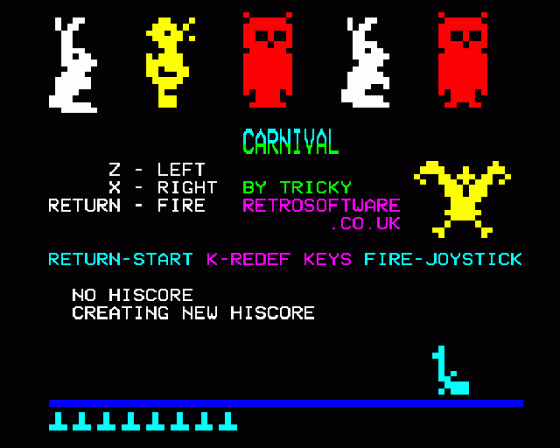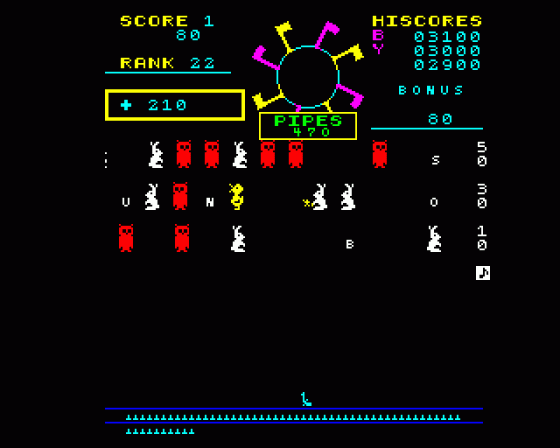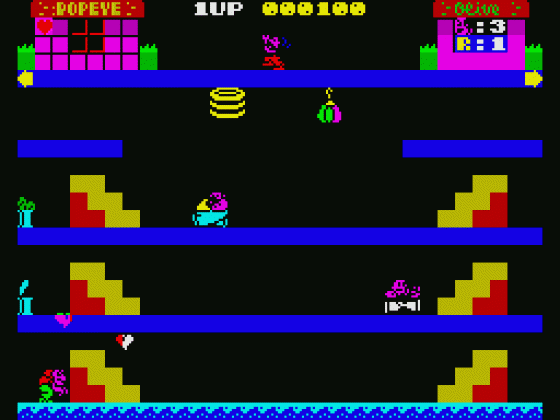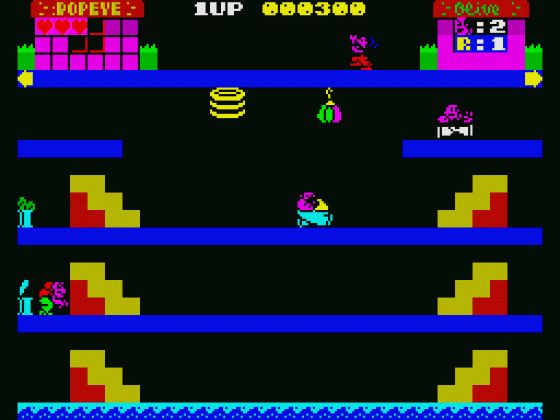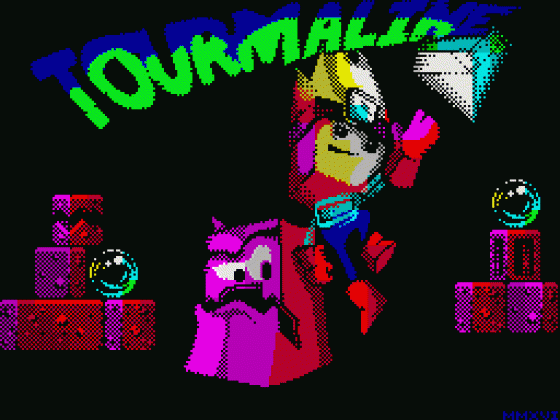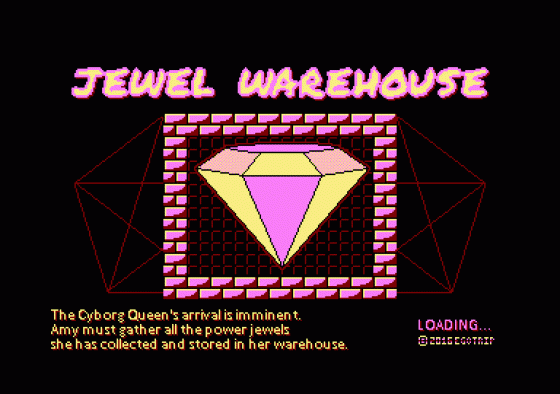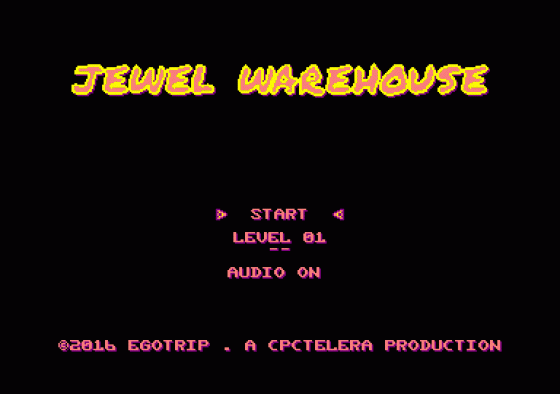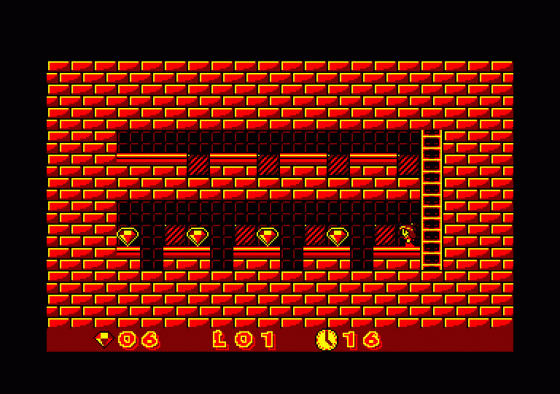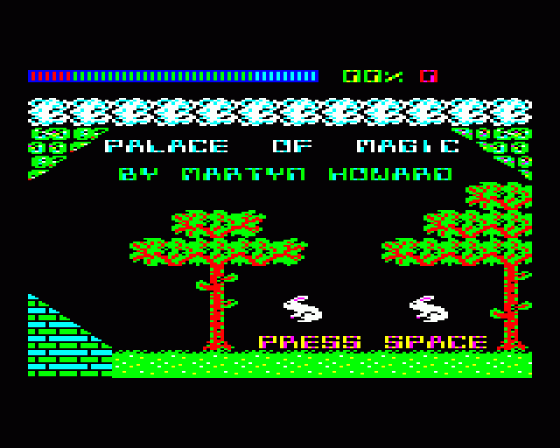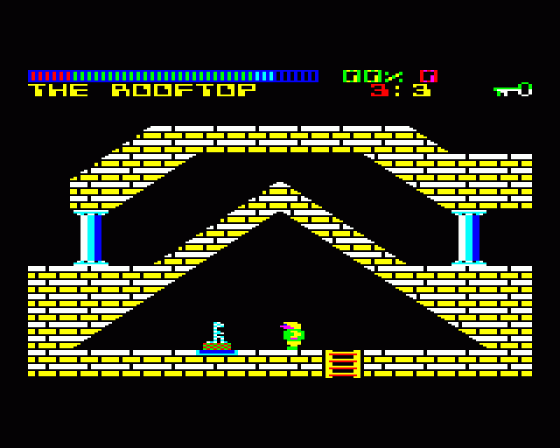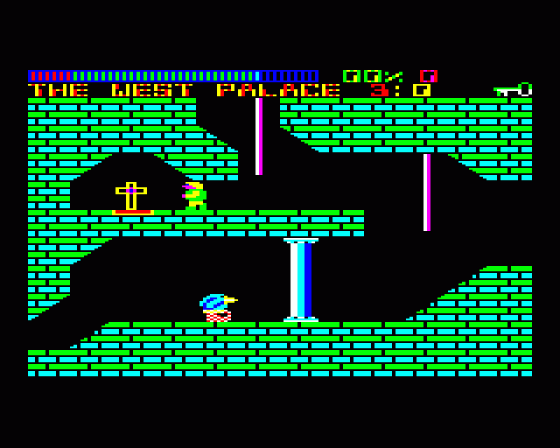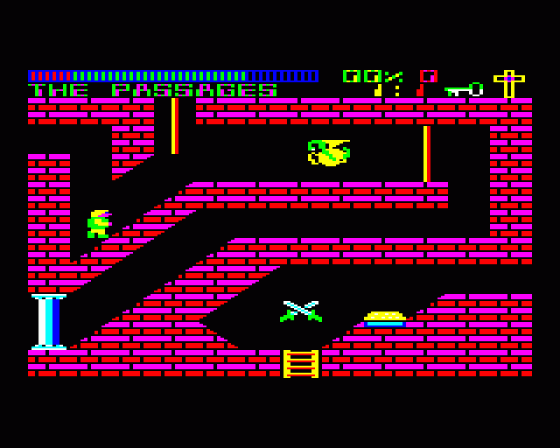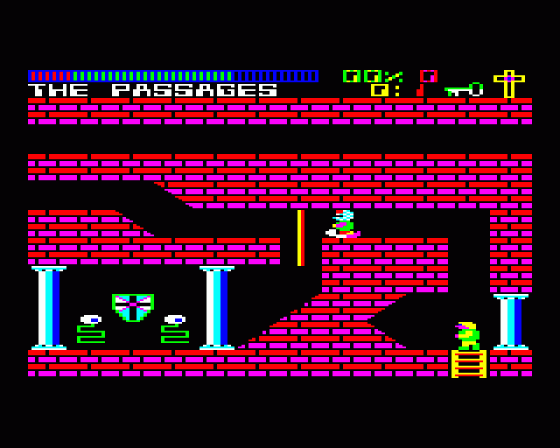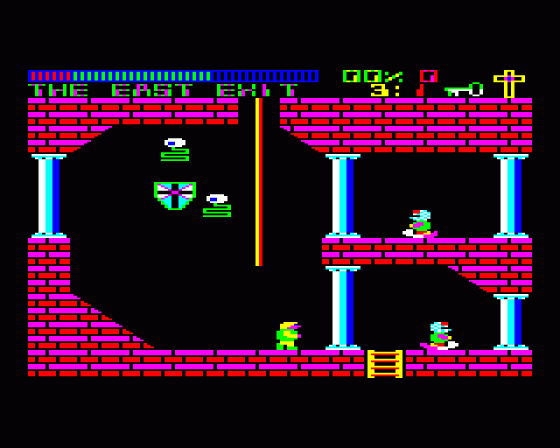
Micro Mart
 21st June 2016
21st June 2016
Author: Dave E
Publisher: Everygamegoing
Machine: Acorn Electron
Published in Micro Mart #1418: June 2016 Special
This month, almost everything "new" is a conversion or revamp of either an Eighties arcade machine (Astro Blaster, Carnival, Popeye), an Eighties icon (Boulder Dash) or an original Eighties trend-setter (Palace Of Magic). Join David Edwards as he discovers if there are more diamonds amongst them than the obvious gleam in Rockford's eyes...
Astro Blaster (BBC Micro, Retro Software, Free, http://tinyurl.com/z6bbe43)
If you were around the early Eighties arcade parlours, you might recall Astro Blaster. One of Sega's early games, it's a vertical shoot-'em-up. It equips you with a laser and invites you to clear waves of aliens, but requires you to "pace yourself" to actually do so.
The problem is that, each time you unleash a bullet, there is a small increase in the temperature of the "blasters" of your ship. If you act like a kamikaze Rambo, it won't be too long until the blasters overheat and refuse to work until they've cooled. Instead, you must duck under the alien wave and try to only fire when a bullet is certain to make its mark.
Astro Blaster has now, some 35 years after its arcade debut, appeared on the BBC Micro. Once again it's under the Retro Software label, it's free and it's coded by Richard 'Tricky' Broadhurst who also gave us the arcade conversion of Frogger raved about in MM #1410.
As with Frogger, Astro Blaster is a flawless conversion of the Sega arcade game. It uses the BBC's high definition, four colour mode (Mode 1), retaining the arcade's detail, colours and resolution. Indeed, it even includes the famous "Fighter pilots needed in sector wars" sampled speech (Not often that Beeb games talk!). Sound otherwise is restricted to blasting and blipping noises, but, all told, it's a nice enough game.
A nice enough game, that is, for those who are fans of the arcade. I'm not one of them. Firstly, I don't like being forced to "pace myself" in the way this game demands. Enduring ten second stretches without being able to fire irritates me. Secondly, that strategy of pacing I described earlier does not actually work. The sheets of aliens here very rarely bob about in a formation that allows you to pick them off with strategy. No, the aliens bob around. More often than not, if you hit one it's a matter of luck rather than judgement. Which means, to stand any chance of taking them out, you have to unleash the very volleys of firepower that overheat the blasters in the first place!
Thirdly, some formations immediately come streaming down the screen and sit literally millimetres from the tip of your spacecraft. You are expected to get underneath these and take them out. An exercise in impossibility.
So, whilst this is undoubtedly yet another amazing feat of programming, I am somewhat lukewarm to it. Personally, I'd much rather load up BBC shooters Galaforce or Firetrack.
Scores: Astro Blaster
Graphics 65%
Sound 35%
Playability 75%
Technical Achievement 100%
Overall 69%
Carnival (BBC Micro, Retro Software, Free, http://tinyurl.com/zc5ecoe)
Carnival is another Eighties Sega arcade machine now coded up on the BBC Micro by Richard Broadhurst of Retro Software. This man must never sleep...
Carnival is quite a simplistic game. The object of the game is not to run out of bullets. This equals instant game over. You start the game with 60 of them and a laser base at the bottom of the screen facing three stacked, scrolling rows of mixed ducks, rabbits, bullets and the letters B, O, N, U and S.
Ducks on the bottom row are a constant menace because they can, without warning, dive towards the bottom of the screen and munch away a random number of your bullets.
Shooting anything on the left hand side of the screen is riskier than elsewhere because, if you miss, you may find your bullet hits a penalty box, also erasing bullets.
Obviously, firing bullets loses them too. Only shooting boxes of bullets will replenish them.
And so the scene is set for a rather chaotic game in which you can employ a myriad of strategies to try and gain that coveted top rung of the high score table. All the action is set to a typical fairground piece, with bullets giving a satisfying squelch on impact.
This new game doesn't actually offer anything particularly new; there are at least two other versions of it already on the BBC Micro with comparable qualities. But it's enjoyable as, being a direct port of the arcade original, it's like playing the "official" conversion. Which is kind of cool.
Scores: Carnival
Graphics 50%
Sound 50%
Playability 80%
Technical Achievement 100%
Overall 70%
Popeye (Spectrum 48K/128K, Gabriele Amore, Free, http://tinyurl.com/j6fdv5a)
You may remember our coverage of Popeye for the Vic 20 in MM #1390. Beamrider faithfully converted the arcade original, pushing the Vic 20 to its limits and I awarded it an overall mark of 70%. That was despite its blocky graphics and the occasional difficulty in discerning what was going on due to the cramped playing area. Gabriele Amore has now attempted the same job on the Spectrum 48K.
The basic premise of the game is that you play Popeye the sailorman collecting the hearts thrown into the playing area by Olive Oyl. You must avoid Bluto, and the bottles he throws at you, and must collect up a quota of hearts to proceed to the next level.
With an extra 32K to play with on the Spectrum compared to the Vic, you'd be forgiven for expecting the same game with better graphics. I was expecting that when I loaded it up. I was very quickly disabused of these expectations.
Honestly, there are so many problems here that I find it difficult to know where to begin.
Firstly, there are no instructions. This was also a problem with the Beamrider version. The original arcade game contains a large amount of "cartoon style" features (being able to drop a bucket on Bluto's head, for example) but without any indication of how to operate them, you're left with your own guesswork. This is time-consuming, annoying and unnecessary. If you can be bothered to convert a game, then supply it with some instructions so that those who want to play it can indeed do so.
Start the game and you get the familiar four level screen one with Olive at the top, and Bluto pacing around below. So far, so good. Oddly, the screen freezes and you have to press M to start the game at this point. I have no idea why but let's do that and get the action going.
Your problems begin almost immediately. In the original, you descend from the starting platform by going to the extreme right and walking diagonally down the stairs. But in this version, the stairs are, in fact, the biggest danger to your health. Firstly, they are not hard right against the sides of the screen, so it's possible to fall off them into a 24px wide area that doesn't exist in the original. This is the exact area often occupied by the bottle-throwing Sea Hag. You see the problem?
Having worked out that you must spin around and sort of 'fall' down the stairs diagonally (that is, walking to the edge of them and landing on the next one), you may need to immediately retrace your steps because Bluto is on the platform throwing bottles at you. In the original, it's a synch, diagonal up-right as you would expect. Here you must actually jump up the stairs one at a time. This takes time you don't have. Don't even get me started on trying to attempt from the final stair up to the platform above - you're more likely to throw your Spectrum out of the window than pull this off! Oh, and none of these quirks affect Bluto. He doesn't have to jump the stairs at such a slow speed, so he will immediately catch up with you. And that's one life down.
Next, everything moves in 8x8 CHR$ "jumps" rather than by smoothly-scrolling machine code. This means that, even if you keep well out of the way of the Sea Hag and Bluto, their bottles come jumping across a very small area at breakneck speed whilst the best your character can do to avoid them is waste a screen-move executing the "punch" or jump in the air.
Not that jumping in the air helps - the collision detection is so bad that, although Popeye is safely out of harm's way mid-air, the bottle still registers a hit and that's two lives down.
What about the famous cans of spinach that render you impervious to Bluto? Surely collecting one of those would make the game playable, even if just for a short time? Well, I wouldn't know. As you can see from the screenshots, there are two accessible cans of spinach only a short walk from the starting position. However, one of them is positioned almost permanently behind the Sea Hag and the other doesn't seem to get picked up even when you walk right up to it and hammer on the fire button. Or maybe it is picked up and I am invincible to Bluto but I just don't know it because there's absolutely no change that would reflect it.
How terrible is this conversion? Well, if you stand extreme right and press the punch key, you'll see your extended first appear one line down screen left!
On a good day, you might just be able to collect up enough hearts (by good luck rather than any skill) to see the second screen. I haven't managed it and I have really tried. It's so difficult just to move about that you'd have to be suicidal to try and attempt any of those more "cartoony" inclusions. Mind you, I'd doubt if they're even implemented properly. There's no intro with the Popeye music, Popeye doesn't blow his toot-toot pipe, and even the introduction with the two competing for Olive's attention is missing. In addition, even the simple arcade quirks (which Beamrider all managed to include in a computer a third of the Spectrum's size) are missing. Bluto never even tried to grab me from the platform above or below!
The only good thing about it is the music, apparently added after the code itself was written by Alexandro "Seto Taisho" Grussu.
If your programming skills aren't up to the job yet, don't start with a "fast and furious" arcade conversion like Popeye. It's a waste of time for everyone.
Scores: Popeye
Graphics 25%
Sound 70%
Playability 5%
Technical Achievement 0%
Overall 25%
Tourmaline (Retro Souls, Spectrum 48K, Free, http://tinyurl.com/zmkyj3g)
When other publishers are churning out the latest definitive version of a familiar format, Retrosouls always seems to be playing with that format a little to produce a wholly new type of game. The force behind Gravibots, Special Intergalactic Painter and Alter Ego now gives us a cross between Boulder Dash and Bomber Man: Tourmaline.
Most people know the Boulder Dash formula; it's an overhead maze game where every sprite is a 32x32 job, and you tunnel through blocks of earth, collecting the diamonds and trying to avoid the rocks, which will fall if not balanced on earth.
Even more people know of Bomber Man; even the modern(ish) system like the Nintendo DS have versions of this overhead maze, where you drop bombs to blow up patrolling nasties.
Put them together and you get Tourmaline; essentially Boulder Dash with bombs. You take control of "Bombford" (Boulder Dash featured a character called Rockford) and your task is, as you might expect, to collect up the diamonds from each level. Levels are several times the screen size and scroll up, down, left or right when you reach an appropriate area of the screen. The scrolling that does this is very jerky.
Given the legendary coding skills of Denis Grachev, the jerky scrolling is entirely intentional. Boulder Dash had the same; it's an affectionate nod to the original and done that way to please the fans of it. Indeed, it's quite odd how this jerky scrolling affects the dynamics of the Boulder Dash/Tourmaline experience. On most professional maze games, smooth scrolling is employed, keeping Rockford in the centre of the playing area. Employing this technique necessarily slows the game down. If you dispense with it and simply shift the screen 32 characters in any direction, you get an absolutely frantic gaming experience. Hence the name Boulder "Dash" - in Tourmaline too, you can race about the mazes at manic speed, unseating boulders, collecting diamonds, avoiding nasties and causing complete chaos.
Equipping your character with an infinite supply of bombs too also ups the ante. If Tourmaline were a puzzle game - that is, if you had to complete each screen a certain way to be assured of success - then allowing you to blast rocks to smithereens would, of course, totally counteract that logic. But Tourmaline isn't a puzzle game. Granted, it looks like one. But it's 100% arcade action. When you're dealing with patrolling nasties coming at you through that jerky scrolling, whilst rocks and diamonds rain down all around you and you need to blast patrolling monsters too, it takes the game to a whole new level.
Tourmaline is one of those games that, now it exists, will satisfy a thirst that Boulder Dash fans hitherto never knew they had. It's free, it's frighteningly addictive and yet another addition to Retrosouls' growing catalogue of tremendous Speccy games. Each game gives you five lives, and you'll need them.
Scores: Tourmaline
Graphics 50%
Sound 67%
Playability 84%
Technical Achievement 84%
Overall 71%
Jewel Warehouse (Amstrad CPC, Ego-trip, Free, http://tinyurl.com/gvyc9yt)
I haven't seen anything from Amstrad publisher Ego-trip before, but a new game for the Amstrad CPC is always welcome, and Jewel Warehouse is a surprisingly addictive puzzle/platform game which rehashes some familiar elements.
There are very few instructions for this game and, indeed, it's one of those games designed in such a way that you don't need them. It's obvious from the get-go that your aim is to collect the ten jewels from each screen, that you can stand on stripy boxes and that you will die if you fall on the spikes.
Throughout the game a sprightly little tune plays, and there's no lives system. You can retry each level as many times as you wish and, as they increase, so do the 'elements' present on them. Conveyor belts - which can leave you stranded in a section of the screen - are introduced circa screen three. Fires - which need to be put out by a collectable extinguisher - are introduced circa screen five. Disappearing platforms come later.
Jewel Warehouse is colourful and very responsive, working with cursor, joystick or the traditional (Amstrad) AZNM key controls. In many ways it's what any game should be all about: It's remarkably easy to get into and quite fun to play. The earlier screens you can dive into without any thought whilst, on later ones, you'll find yourself having to ponder over the solution before you start.
If I had one criticism, it would be that it doesn't try to do anything really "new". Retrosouls' recent Alter Ego (available for the Spectrum, Amiga and Nintendo, see MM #1393) really astonished me with a wholly new twist on the traditional platformer. This is good - but it's standard platform fare, and by no means astonishing.
Scores: Jewel Warehouse
Graphics 63%
Sound 55%
Playability 75%
Technical Achievement 73%
Overall 67%
Palace Of Magic 2016 (Acorn Electron, Mr. Quazar, TBA, http://tinyurl.com/z25s7at) - Retro Find Of The Month
Unlike the BBC Micro, its brother the Acorn Electron hasn't had a new game in years. This may seem quite puzzling considering the two share the same Basic/Assembly language firmware but the two machines themselves are intrinsically different. The low-resolution, seven colour Mode 2 of the BBC, for example, runs about 190% faster than the same Mode on the Electron. This meant that, back in the day, you would often find new games released with a BBC version on one side of the cassette and an Electron version on the other. The BBC version was always superior.
A case in point is Palace Of Magic, which was written by Martyn Howard and released in November 1987. The BBC Micro received a glorious seven colour Mode 2 version. The Electron received a less-glorious four colour Mode 5 version, its author choosing to redesign all of the sprites of the palace rather than try to stick with Mode 2 on the Electron and try to reduce processing time.
Well, some thirty years later, Palace Of Magic 2016 manages to recreate the original BBC Micro Mode 2 palace on an Acorn Electron. In the game, which was a sequel to the genre-defining Citadel, you play Caldeti, reduced to the size of a midget and stranded in the palace of an offended God. Your task is to solve the mysteries of the Palace Of Magic by bounding about, shinning up the ropes, avoiding the patrolling nasties on the platforms and moving the items you find around the rooms allowing every route through the palace to be opened up. Once you've managed it, you will discover a transporter to quit the palace and will be restored to your normal height. In short, what became typical graphic adventure fare.
Great touches of the game include the "red screen save routine" which, if you plunge into a pit of spikes or spend too much time occupying the same sprite space as one of the baddies, automatically transports you back to the point at which you entered the room. There's also much more involved than "find key A and unlock door A with it". A pair of magical boots will allow you to jump three times as high when collected, for example. A sword will allow you to start wiping out certain nasties rather than just having to jump them. A candle will light up dark rooms. A coiled rope will automatically uncoil in the right place. And so on.
In assessing Palace Of Magic 2016, you really need to compare it not with just the original Acorn Electron version but with the BBC version it has been converted from. Differences in the hardware between the two machines, for example, mean that, on the BBC, a short piece of machine code will "shake" the screen. So if Caldeti falls a long way, the impact will not only drain his energy bar but will send the screen twanging up and down. The Electron has no hardware scrolling whatsoever, so the original version simply dropped this effect. This new version somehow manages to replicate it!
The lack of colours in the Acorn Electron version also led to the keys and doors being completely different to the BBC. Where the BBC could use many different colour combinations to represent the keys and doors, the Electron owner was reduced to letter codes. Instead of a yellow and blue key, they got a simple key labelled A. This new version dispenses with these shortcomings too.
Indeed, no programming stone seems to have been left unturned in the author's own quest to wring every last instruction out of every last machine code cycle on the little Elk. The game even automatically compensates for whether the Electron it is running on is equipped with the Master Ram/Turbo board. The only real difference I found was that, on some emulators, the sound made when Caldeti jumped seemed to be about a quarter of a second too late.
Overall though, this is a much improved version of the Electron Palace Of Magic and any Acorn Electron owners who have never seen this superior version should be advised to get it immediately.
Scores: Palace Of Magic 2016
Graphics 83%
Sound 33%
Playability 90%
Technical Achievement 100%
Overall 77%
That's It!
With so much new stuff, there was no time for lengthy intros and outros this month. All of the games featured are free to download, so follow the tinyurls to Everygamegoing to download any that interest you. See you next month!





